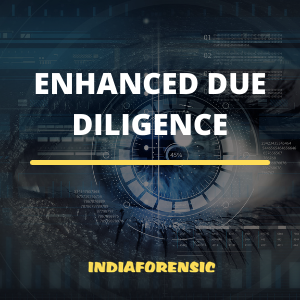Banks and Financial Institutions are covered under AML Laws. They must understand the customer to avoid being potentially abused for money laundering. They do certain checks based on business relationships. These checks can be simpler (Simplified Due Diligence or SDD), regular (Customer Due Diligence or CDD), or more detailed (Enhanced Due Diligence or EDD) based on the level of risk.
When financial institutions are dealing with high-risk customers, they have to go beyond basic customer due diligence. Though it is a KYC process, enhanced due diligence provides a greater level of scrutiny of potential business partnerships. It highlights the risk that the regular background check process will never reflect.
What is Enhanced Due Diligence?
Enhanced Due Diligence EDD processes require banks to take a risk-based approach to look into customer KYC. Under this approach, banks verify the identities of their customers and confirm the source of funds is legitimate.
This can be an ongoing process, as existing customers have the potential to transition into higher-risk categories over time. The financial sector is plagued by high-risk category customers across the world. Hence, conducting periodic due diligence assessments leads to AML compliance.
When doing Enhanced Due Diligence (EDD), a challenge is figuring out how much information about a customer is needed. One way to solve this problem is by using a risk rating approach based on various factors. Enhanced Due Diligence is usually required for high risk customers.
A high-risk customer refers to an individual or entity that, based on certain factors, is deemed more likely to be involved in activities related to money laundering, terrorism financing, or other financial crimes. Financial institutions, businesses, and entities subject to anti-money laundering (AML) regulations categorize customers based on the level of risk they pose. High-risk customers require additional scrutiny and monitoring to ensure compliance with AML laws and regulations.
Riskpro has created a risk rating model using HRE scores, where HRE stands for Heightened Risk Entities. This model uses 27 different factors to decide the level of risk for customers, especially those who are considered high-risk.
Why EDD is Important?
Enhanced Due Diligence (EDD) is crucial in preventing financial crimes like money laundering and terrorist financing. Imagine you’re buying something online, and the seller asks for extra verification before completing the transaction. Similarly, EDD is like that extra check for businesses and financial institutions when dealing with customers who might pose a higher risk of being involved in illegal activities.
The main reason EDD is necessary is that it adds an extra layer of protection. Some customers or transactions are like red flags—they need a closer look. EDD involves digging deeper into who these customers are, where their money comes from, and if there’s anything suspicious going on.
The FATF recommends some practical steps for EDD. These include obtaining additional identifying information from a wider variety of sources such as doing more searches, and checking where the money comes from. To make sure it’s not from illegal activities, ask customers more about why they’re doing business and what it’s about. Sometimes Commissioning an intelligence report on the customer or beneficial owner is necessary.
Certification for Due Diligence
The Certified Bank Forensic Accountant program deals with different techniques of gathering market intelligence. The due diligence process requires ongoing monitoring of high-net-worth individuals, site visits, and gathering detailed information about the borrower. This course helps bankers in developing the skills to perform EDD work efficiently. This course focuses on various sessions to assess the risk. Detailed information on this course is available in the banking fraud section
Enhanced Due Diligence Factors
Customer Risk Factors
Some circumstances can lead to EDD. Here are six scenarios.
- Firstly, the customers are non-residents or foreign citizens.
- Secondly, the customer is an asset-holding company with no real business.
- Thirdly, when the customer is a PEP, or PEP’s close associates or family members. One can check the PEP databases for the same. A politically exposed person is a term describing someone who has been entrusted with a prominent public function. Or an individual who is closely related to such a person. A PEP generally presents greater risks for potential involvement in corruption. The risk they pose is by their position and the influence that they may hold.
- Next, your customer has nominee shareholders or shares of the company are issued in bearer form.
- Next, your customer is a cash-intensive business such as the owner of a petrol pump or a retail shop in a big mall.
- Where there is a high risk of money laundering such as gambling business.
- And lastly, your customer transactions will exceed certain limits in the number of daily cash transactions.
Geographical Risk Factors
Secondly, there are geographical risk factors that can lead to EDD. These factors include the following six scenarios.
- Countries with inadequate money-laundering prevention systems. For example North Korea and Iran. They are on the lists maintained by FATF. Pakistan is on the Greylist.
- Countries under sanctions and embargoes or similar measures.
- Countries are known for prevalent levels of corruption. For example, Venezuela, and Yemen are on the transparency index list.
- Countries are sanctioned for financing or supporting terrorist activities. These countries may include Iran, Syria, and Sudan.
- Locations where designated terrorist organizations are operating. For example Syria, Iraq, and Somalia.
- Countries that are not members of the Financial Action Task Force and its partners.
Additional Risk Factors in EDD
In terms of additional risk factor categories, there can be other risk factors that might lead to enhanced due diligence. It is rather individual to certain types of organizations or financial institutions. This includes private and correspondent banking for example. Hence, they are naturally more prone to money laundering than others.
EDD also takes into consideration all relevant negative media related to the account holder. An official document or a post made on the Internet, any information about money laundering or financial crime forms part of the examination.



